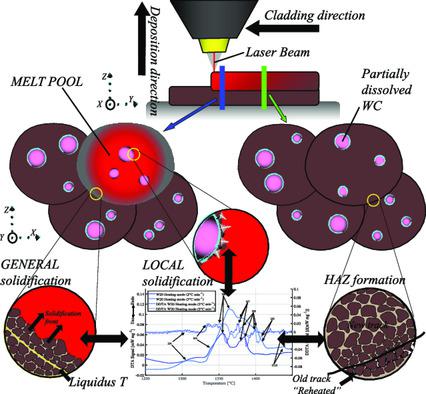当前位置:
X-MOL 学术
›
Adv. Eng. Mater.
›
论文详情
Our official English website, www.x-mol.net, welcomes your
feedback! (Note: you will need to create a separate account there.)
Microstructural and Thermal Characterization of 316L + WC Composite Coatings Obtained by Laser Cladding
Advanced Engineering Materials ( IF 3.4 ) Pub Date : 2020-05-28 , DOI: 10.1002/adem.202000291 Tommaso Maurizi Enrici 1 , Olivier Dedry 1 , Frédéric Boschini 2 , Jérôme Tchoufang Tchuindjang 1 , Anne Mertens 1
Advanced Engineering Materials ( IF 3.4 ) Pub Date : 2020-05-28 , DOI: 10.1002/adem.202000291 Tommaso Maurizi Enrici 1 , Olivier Dedry 1 , Frédéric Boschini 2 , Jérôme Tchoufang Tchuindjang 1 , Anne Mertens 1
Affiliation

|
Herein, a metal matrix composite (MMC) composed of 316L stainless steel and 20% in volume of tungsten carbides (WC), fabricated by laser cladding (LC) is considered. LC is an additive manufacturing technique, characterized by ultrafast cooling rates and limited diffusion, thus giving rise to out‐of‐equilibrium microstructures. The microstructure of the MMC is found to consist of partially dissolved WC well distributed in an austenitic matrix reinforced by a network of reaction carbides. Those mixed reaction carbides are formed from a liquid enriched in W and C due to the dissolution of the original WC in contact with the molten metal during deposition. Distribution, chemical composition, crystallographic features, and stability of the different phases are characterized in details by combining electron microscopy, electron backscattered diffraction, and dilatometry. This combination of techniques allows to distinguish among M6C, M23C6, M4C, and WC1–x carbide, belonging to the Fe–W–C system and all exhibiting a face‐centered cubic lattice. Moreover, results of reverse thermal analyses are considered together with microstructural data to elucidate the genesis of this complex microstructure, differentiating the phases formed in the melt pool, in the vicinity of partially dissolved WC and in the heat‐affected zone between two successive tracks.
中文翻译:

激光熔覆获得的316L + WC复合涂层的组织和热特性
在此,考虑通过激光熔覆(LC)制造的由316L不锈钢和20%体积的碳化钨(WC)组成的金属基复合材料(MMC)。LC是一种增材制造技术,其特征在于超快的冷却速度和有限的扩散,因此会导致微结构失衡。发现MMC的微观结构包括部分溶解的WC,该WC很好地分布在由反应碳化物网络增强的奥氏体基体中。由于沉积过程中与熔融金属接触的原始WC的溶解,这些混合的反应碳化物由富含W和C的液体形成。结合电子显微镜,电子反向散射衍射,和膨胀法。这种技术组合可以区分M6 C,M 23 C 6,M 4 C和WC 1– x碳化物,属于Fe–W–C系统,均表现出面心立方晶格。此外,将反向热分析的结果与微观结构数据一起考虑,以阐明这种复杂的微观结构的成因,区分在熔池中,部分溶解的WC附近和两个连续轨道之间的热影响区中形成的相。
更新日期:2020-05-28
中文翻译:

激光熔覆获得的316L + WC复合涂层的组织和热特性
在此,考虑通过激光熔覆(LC)制造的由316L不锈钢和20%体积的碳化钨(WC)组成的金属基复合材料(MMC)。LC是一种增材制造技术,其特征在于超快的冷却速度和有限的扩散,因此会导致微结构失衡。发现MMC的微观结构包括部分溶解的WC,该WC很好地分布在由反应碳化物网络增强的奥氏体基体中。由于沉积过程中与熔融金属接触的原始WC的溶解,这些混合的反应碳化物由富含W和C的液体形成。结合电子显微镜,电子反向散射衍射,和膨胀法。这种技术组合可以区分M6 C,M 23 C 6,M 4 C和WC 1– x碳化物,属于Fe–W–C系统,均表现出面心立方晶格。此外,将反向热分析的结果与微观结构数据一起考虑,以阐明这种复杂的微观结构的成因,区分在熔池中,部分溶解的WC附近和两个连续轨道之间的热影响区中形成的相。











































 京公网安备 11010802027423号
京公网安备 11010802027423号